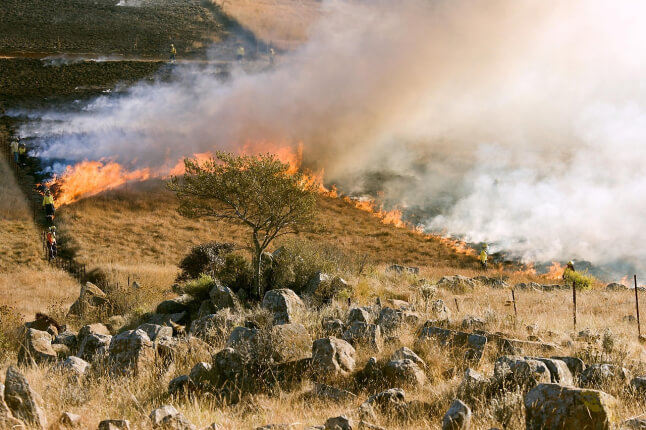News
Global COVID-19 cases and ultraviolet radiation (UV) in winter 2020. Red bars show average daily cases from November 1, 2020 - December 2, 2020 (data from Johns Hopkins University and are either national or subnational depending on data availability). The map shows average UV during the same time period, with yellows showing high UV and oranges showing lower UV. (Image courtesy of Tamma Carleton, Jules Cornetet, Peter Huybers, Kyle C. Meng, and Jonathan Proctor)
Natural variations in ultraviolet radiation influence the spread of COVID-19, but the influence is modest compared to preventive measures such as physical distancing, mask wearing, and quarantine, according to new research from Harvard University.
“Understanding the potential seasonality of COVID-19 transmission could help inform our response to the pandemic in the coming months,” said Jonathan Proctor, a postdoctoral fellow at the Harvard Data Science Initiative and the Harvard Center for the Environment. “These findings suggest that the incidence of COVID-19 may have a seasonal pattern, spreading faster in the winter when it’s darker than in the summer.”
Analyzing daily COVID-19 and weather data from over 3,000 administrative regions in more than 170 countries, Proctor, together with co-authors Peter Huybers, also at Harvard University, Tamma Carleton and Kyle Meng from the University of California Santa Barbara and Jules Cornetet at France’s École Normale Supérieure Paris-Saclay, found that the spread of COVID-19 through a population tended to be lower in the weeks following higher UV exposure. Findings were published in the Proceedings of the National Academy of Sciences.
The seasonality of COVID-19 has been a mystery since the disease first emerged one year ago, though there have been some clues that UV could play a role. Related species of coronaviruses such as SARS and MERS were found to be sensitive to UV radiation and recent laboratory studies show that UV inactivates SARS-CoV-2, the virus that causes COVID-19, on surfaces.
Attempts to understand the influence of UV in the real world, however, have been limited by scarce data and the difficulty of isolating climate variables from other drivers of transmission. To test for an environmental signal within the noise of the pandemic, the team compiled and cleaned data from statistical agencies around the world. To avoid potentially confounding factors that differ across regions, such as healthcare infrastructure or population density, the team examined how transmission within a particular population changed according to variations in sunlight, temperature, precipitation and humidity experienced by that same population.
“We basically ask whether daily fluctuations in environmental conditions experienced by a population affect new COVID-19 cases up to two weeks later,” Meng explained.
The researchers diagnosed the relationship between UV and COVID-19 using data from the beginning of the pandemic and then used that relationship to simulate how seasonal changes might influence the spread of COVID-19. They found that changes in UV between winter and summer led to a 7-percentage point decrease in the COVID-19 growth rate on average across the Northern Hemisphere, which is about half the average daily growth rate at the beginning of the pandemic. While this research shows that COVID-19 exhibits a seasonal pattern due to changes in UV, the full seasonality of COVID-19 remains unclear because of uncertain influences from other environmental factors such as temperature and humidity.
“We are confident of the UV effect, but this is only one piece of the full seasonality picture,” Carleton said.
The team noted that environmental influences are just one of many determinants of COVID-19 transmission, and that the estimated effects of UV seasonality in the Northern and Southern Hemispheres are a fraction of the size of previously estimated effects of anti-contagion policies including quarantines and travel bans.
“As we saw in the U.S. this summer, UV exposure alone is unlikely to stop the spread of the virus without strong social distancing policies,” said Proctor. “Regardless of the weather, additional measures appear to be necessary to substantially slow the spread.”
The team analyzed the data in multiple ways and consistently found that the higher the UV, the lower the spread of COVID-19, but it remains unclear what mechanism is driving that effect. It may be that UV destroys the virus on surfaces or in aerosols, or that on sunny days people go outside more where there is less transmission. It is even possible that UV reduces susceptibility to COVID-19 by stimulating production of vitamin D and boosting the immune system.
“There’s still so much that we don’t know about how environmental factors both directly and indirectly, though human behavior, influence the spread of the virus,” said Huybers. “But a better understanding of the environmental influences on COVID-19 could allow for seasonal adjustment of containment policies and may help inform vaccination strategies.
Topics: Environment
Cutting-edge science delivered direct to your inbox.
Join the Harvard SEAS mailing list.
Scientist Profiles
Peter John Huybers
Professor of Earth and Planetary Sciences and of Environmental Science and Engineering
Press Contact
Leah Burrows | 617-496-1351 | lburrows@seas.harvard.edu




